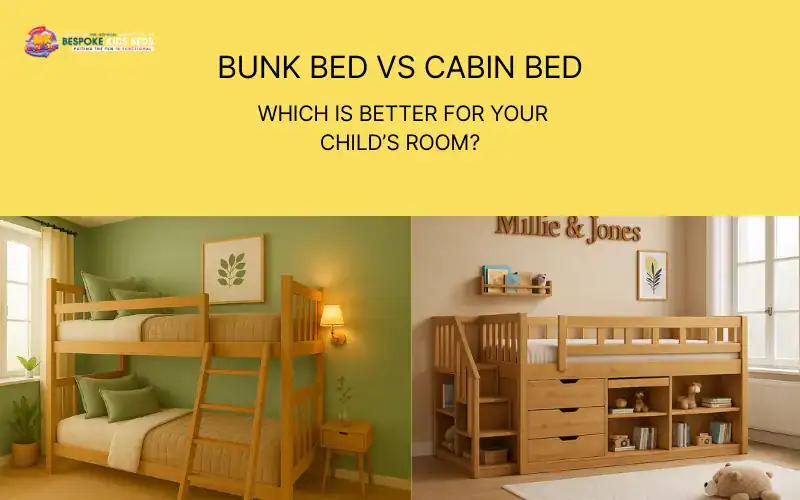
Creative Ideas to Maximise Storage Space in Small Bedrooms
To maximise storage space in a small bedroom, focus on utilising vertical space with shelves or tall cabinets, and opt for multifunctional furniture like bunk
Enjoy FREE Delivery on All Orders!

Bunk beds and cabin beds are two of the most popular options, both offering unique features that maximise space and create a safe, comfortable sleeping area for children. When it comes to designing a child’s room, space-saving furniture is essential for maintaining a clutter-free, functional environment. For families with limited space, choosing the right bed can make all the difference.
Bunk beds are ideal for families with multiple children, as they allow two or more kids to sleep in the same room while saving precious floor space. On the other hand, cabin beds provide additional storage solutions, perfect for families with a single child who needs extra room for toys, books, or clothes.
We will compare the core features of both bed types, highlighting their design, advantages, and limitations. From their structural differences to storage capabilities and suitability for different room sizes, we will guide you through which bed is the best fit for your child’s room.
A bunk bed features two or more sleeping surfaces stacked vertically, maximising floor space. It’s ideal for siblings sharing a room or families needing extra sleeping arrangements. Built from durable materials like wood or metal, bunk beds often include additional features like storage or play areas, offering both functionality and versatility. If you’re interested in bunk beds with additional storage, explore our Bunk Beds with Storage.
Bunk beds are a great solution for families with limited space, offering an efficient way to accommodate multiple sleepers in a single room. They are particularly useful in shared bedrooms or smaller spaces where maximising floor area is essential. Modern bunk beds come with a range of features ensuring safety, comfort, and functionality, making them ideal for both children and adults. With sturdy construction and versatile designs, these beds are tailored to suit various needs and preferences.
Key Features of Bunk Beds:
Bunk beds are an excellent choice for families looking to save space while maintaining functionality. Their design offers numerous benefits, especially in shared or small rooms. Let’s explore the advantages bunk bed bring:
While bunk beds offer numerous benefits, there are a few drawbacks that should be considered before making a decision. Proper understanding of these limitations will help ensure bunk beds are the right choice for your child’s room.
A cabin bed is a mid-height bed designed to maximise space in children’s rooms by offering built-in storage or additional features underneath. Perfect for smaller rooms, these beds combine sleeping and storage areas, with options like desks, drawers, and play spaces. To understand what a cabin bed is and how it works, we’ll explore its key features, advantages, and limitations to help you decide if a cabin bed is the right choice for your child
Cabin beds are designed to maximise space and provide multifunctional solutions for smaller rooms. With a mid-height design, these beds create valuable space underneath for storage, play, or study areas. Below are the key features that make cabin beds a popular choice:
Cabin beds are designed to maximise space and provide multifunctional solutions for smaller rooms. With a mid-height design, these beds create valuable space underneath for storage, play, or study areas. Below are the key features that make cabin beds a popular choice:
While cabin beds offer numerous advantages, they may not be ideal for every room or child. These beds come with certain drawbacks that should be carefully considered to ensure they fit both your child’s needs and your home’s layout. Here are some key disadvantages of cabin beds to keep in mind:
Bunk beds and cabin beds both save space but cater to different needs. Bunk beds stack sleeping areas to fit multiple children, while cabin beds raise a single sleeping area to create space underneath for storage or play. Here are the differences between bunk beds and cabin beds, two popular space-saving beds for children’s rooms.
Bunk beds are tall and designed to maximise vertical space in rooms shared by two or more children. They typically range between 150 and 180 cm in height and need ceilings around 210 to 240 cm high for safety and comfort. Cabin beds are lower, between 90 and 120 cm tall, making them more accessible to younger children and better suited to rooms with lower ceilings. This design helps cabin beds fit well in smaller bedrooms where tall bunk beds might not work.
Bunk beds provide stacked sleeping areas, allowing two or more children to sleep in the same room without taking up extra floor space. They come in many styles, such as twin-over-twin or full-over-full, and some models include trundle beds for extra guests. Cabin beds generally offer a single sleeping area raised above the floor, with space underneath for storage or play. This makes cabin beds best suited for single-child rooms or smaller spaces where a second bed is not needed.
Storage on bunk beds is usually limited to small drawers or shelves, often built near the bottom bunk or as optional extras. This provides some help with organisation but is not the main feature. Cabin beds focus heavily on storage, with large drawers, cupboards, or even desks built underneath the sleeping area. This makes cabin beds ideal for smaller rooms that need extra space to store toys, clothes, books, or study materials, helping keep bedrooms tidy and clutter-free.
Bunk beds are often designed with simplicity and practicality in mind. They usually feature neutral colours and classic finishes to fit many bedroom styles. Cabin beds are more versatile in design and often come with playful features, such as themed colours, slides, tents, or curtains. This makes cabin beds a great choice for creating fun and imaginative spaces while still providing functional sleeping and storage solutions.
Bunk beds make the most of vertical space, freeing up floor area in shared bedrooms for play or other furniture. However, they require higher ceilings to fit safely. Cabin beds raise the sleeping surface and create valuable floor space underneath for storage, a study nook, or a play zone. This design works well in smaller rooms or single-child bedrooms where making the most of limited space is essential for comfort and organisation.
Comparison Table: Bunk Bed vs Cabin Bed
| Feature | Bunk Bed | Cabin Bed |
| Height | 150 cm to 180 cm | 90 cm to 120 cm |
| Ceiling Clearance | Requires 210 cm to 240 cm | Suitable for rooms with lower ceilings |
| Suitability | Best for larger rooms or shared spaces | Ideal for smaller rooms or younger children |
| Accessibility | Less accessible for younger children | Easier access due to lower height |
| Sleeping Capacity | Accommodates 2 or more children | Typically accommodates 1 child |
| Configuration Options | Twin-over-twin, twin-over-full, full-over-full | Single sleeping area with space underneath |
| Extra Sleeping Space | Some models include trundle beds for extra capacity | Not designed for multiple sleepers |
| Ideal For (Sleeping) | Shared rooms or families with multiple children | Single-child rooms or smaller spaces |
| Storage Options | Limited storage (drawers, shelves, or desks in some models) | Extensive storage (drawers, shelves, cupboards, or desks) |
| Space Utilisation | Storage often limited to area beneath the bottom bunk | maximises space underneath for storage, study, or play |
| Flexibility | Limited flexibility for additional storage | Flexible storage solutions that can be repurposed as the child grows |
| Design Focus | Functionality and space-saving | Customisable with themed and playful designs |
| Style Options | Simple, neutral, and classic finishes | Wide range of themed and decorative designs |
| Customization | Can be personalised with bedding, curtains, or canopies | Highly customisable with colours, themes, and features like slides |
| Space Maximisation | maximises vertical space for multiple sleepers | maximises floor space beneath the bed for storage or play |
| Best For (Room Fit) | Shared rooms with multiple children | Single-child rooms or compact spaces |
Choosing between a bunk bed and a cabin bed depends on several factors, including your room size, how many children need to sleep in the room, and your storage requirements. Bunk beds are ideal for shared rooms and maximising vertical space, while cabin beds are better suited for smaller rooms with single sleepers, offering extra storage or play areas underneath. Consider your child’s age, the layout of the room, and what features are most important when making your decision about choosing a bunk bed or a cabin bed.
Bunk beds are ideal for larger rooms with higher ceilings, maximising vertical space and freeing up floor area, making them perfect for shared spaces. Cabin beds, however, fit smaller rooms by utilising the space beneath for storage or play, making them perfect for single-child spaces or rooms with lower ceilings. Consider your room’s layout and space requirements to determine which bed suits your needs best.
Bunk beds are designed to accommodate two or more children, making them ideal for shared rooms. They come in configurations like twin-over-twin, twin-over-full, or full-over-full, depending on the space. In contrast, cabin beds are typically designed for one child, with a raised sleeping area that offers additional space for storage or play underneath. This makes cabin beds better suited for single-child rooms or smaller spaces, whereas bunk beds are perfect for families needing extra sleeping capacity in shared rooms.
For families with multiple children, bunk beds offer a practical solution by accommodating two or more kids in shared rooms. They come in various configurations like twin-over-twin, twin-over-full, or full-over-full. In contrast, cabin beds are designed for single children, with a raised sleeping area that creates extra storage or play space underneath, making them ideal for smaller rooms.
When choosing between a bunk bed and a cabin bed, cost is an important factor. Bunk beds are generally more affordable, ranging from £150 to £800, depending on materials and features like storage. Cabin beds, on the other hand, tend to be more expensive, ranging from £200 to £1,200, due to their multifunctionality, including built-in storage, desks, and play areas. Customisation options such as themes or slides further increase the price. Bunk beds are ideal for budget-conscious families needing multiple sleeping spaces, while cabin beds are better for those seeking multifunctional storage solutions.
Bunk beds are best suited for children aged 6 and up due to their height and ladder access, while cabin beds are safer and more accessible for younger children, typically from age 3, thanks to their low elevation. Bunk beds come with guardrails and sturdy ladders, but the top bunk poses a higher fall risk. In contrast, cabin beds have sturdy side rails and easy access, minimising the risk of falls and making them ideal for younger children. Cabin beds offer a safer, more accessible option for smaller users.
Bunk beds offer a simple, functional design that integrates easily into various room styles and can be customised with accessories like curtains or bedding. In contrast, cabin beds provide more creative, playful themes, with options like slides or tents, making them more appealing to children’s imaginations. Cabin beds are highly customisable, with built-in storage, play areas, and study spaces, offering greater versatility. Bunk beds are ideal for rooms where functionality is key, while cabin beds are perfect for rooms where style, playfulness, and versatility are prioritised.
Bunk beds save space by stacking sleeping areas, while cabin beds add built-in storage and play zones for extra function and fun. Both are safe, durable, and stylish, making them ideal for growing kids of all ages. The right choice really depends on your needs, your space, and your child’s personality. Whether you’re furnishing a shared room or creating a playful, organised bedroom, MK Furnishings has a wide range of options to suit every space and style.
Explore our bunk bed collection today and find the perfect bed to make your child’s room both practical and magical.
A cabin bed is generally safer than a bunk bed. With its lower height and easier access, it reduces the risk of falls, making it ideal for younger children. Bunk beds, while safe with guardrails, present a higher risk due to their elevated design and require careful supervision.
No, cabin beds typically accommodate only one child. They are designed with a single sleeping area and offer additional space underneath for storage, a study area, or a play zone. If you need to accommodate two children, a bunk bed would be a better option
Bunk beds are suitable for children aged 6 and older. Due to the height and ladder access, they are not recommended for younger children, as they may pose a safety risk. Proper guardrails and supervision are essential to ensure safe use for children in this age group.
Yes, cabin beds are ideal for small rooms. Their raised design creates valuable space underneath for storage, play, or study areas, making them perfect for maximising floor space in compact rooms. This space-efficient design helps keep the room organised while offering functionality for growing children.
Bunk beds are generally more budget-friendly than cabin beds. They offer a cost-effective solution for accommodating multiple children in a shared room, with prices typically lower than cabin beds. Cabin beds tend to be more expensive due to their built-in storage and multifunctional design.
Kyle Kane
Owner
Kyle Kane is Co-Owner of MK Furnishings, a family-run business based in UK that specializes in high-quality custom kids’ bunk beds, including triple, double, single, and themed designs. Since launching the company in 2016 alongside his brother-in-law, Kyle has helped deliver and assemble thousands of beds across the UK, Ireland, and beyond. Focused on customer satisfaction, Kyle leads a hardworking team that handles every step from ordering to delivery ensuring a smooth and professional service. His commitment to quality craftsmanship and reliable support has earned MK Furnishings a strong reputation and growing customer base throughout the region.

To maximise storage space in a small bedroom, focus on utilising vertical space with shelves or tall cabinets, and opt for multifunctional furniture like bunk

To dispose of a mattress in the UK, the major options include recycling, local council collection services, charity donations, or retailer take-back schemes. Each option
Fancy £50 off all orders! Enter in 50off to redeem in the coupon code section